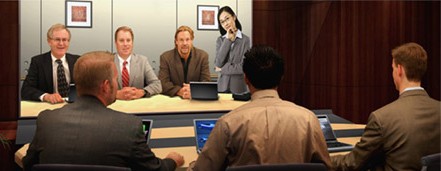According to a whitepaper on the Teliris website, "Business Value of Telepresence", by S. Ann Earon, "Telepresence is what videoconferencing was meant to be: reliable, highly interactive, easy to operate, resulting in a natural meeting with transparent technology and an emphasis on human factors."
Teleris now offers something they call Immersive Collaboration, which involves the use of surface computing that supports document and multimedia content sharing across locations, as if all of the group members are in the same room
Watch the demonstration of the Teliris Collaboration Touch Table in a telepresence meeting. In the video clip below, the narrator shares content from a local Teliris Collaboration Touch Table to a remote meeting participant who is at another table.
"Touch to Telepresence"



Business Holograms!
DVE (Digital Video Enterprises) developed a Tele-Immersion room that uses Cristie Digital Systems Mirage HD 3D projectors to create holographic images of remotely located meeting participants:
DVE Telepresence: An Introduction (A plug from DVE, but informative.)
DVE Portable Virtual Presentation -A Volumetric 3D image from a projector hidden from the audience's view:
This system can display 3D images on the stage, and supports 2-way interactive HD feeds.
The above examples demonstrate how newer technologies, including table-top surfaces, can be used for collaborative business meetings. I can envision this technology used for medical education, medical consultations, and collaboration between artists and musicians.
When the price comes down, perhaps we will have these systems in our family rooms!
2 comments:
Hi Lynn,
Interesting post. I am very curious how this next generation of sensing and display technologies will play out in the telepresence market.
While I am as big a tech pom-pom waver as anyone, half-baked inclusion of multitouch vision systems, 3d and other data-intensive applications seem like a recipe for disaster.
They reopen the Pandora's Box of latency issues that dogged the first decade of haptics/telepresence products.
Too wit, I saw the Teliris package a couple of months back.
It suffers from the sort of latency that kills the sense of "being there". In table top multitouch applications, registered contacts should generate a visual response in 27-70 milliseconds to maintain user flow. The Teliris demo I saw seemed closer to 200.
Optimizing vision systems is a painful process and one worth paying for instead of doing internally.
While I understand Teliris' desire to avoid standardizing on a first rev. of Surface, in the long term, it would be wise to source from Microsoft instead building gimmicky products that stress client datapipes and lack the optimization/user testing budgets to "get it right"...then trying to run around an IP minefield.
~Jonathan Brill
www.pointanddo.com
The world will need a LOT of bandwidth!
Post a Comment